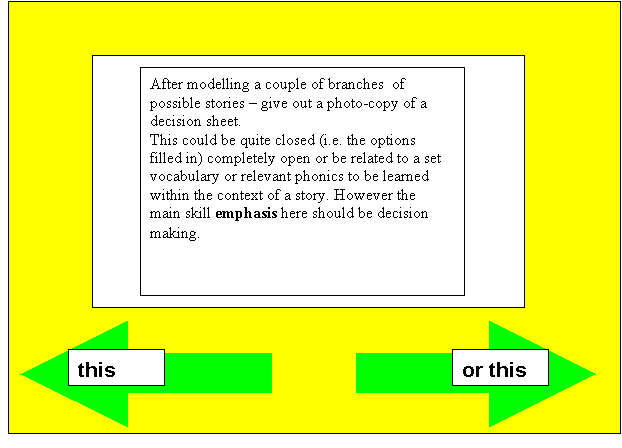Branching Stories
for Early Years with Powerpoint
Leon Cych
All Souls Primary School, London
An
adventure slideshow created in Powerpoint (Microsoft) can be one
very simple starting point to model a branching story. This sort
of activity can also be an excellent way to develop and hone children's
thinking and social skills. It makes them proactive and gets them
right into talking about decisions and decision-making from the
start. In addition it models scenarios in a simple but effective
way. It can be used in a number of different open-ended ways. For
example it could be used to develop thinking and reflection in Circle
time or as a way to develop collaborative discussion and thinking
with young children in specific curriculum contexts or with familiar
stories. As always with early years children it shouldn't be used
out of context.
Adventure
or "decision making" branching stories help develop "soft"
and interpersonal social skills. Some children in your class may
not be used to discussions where this kind of modelling goes on
- this is the ideal opportunity to build a structure that enables
you to build in opportunities to develop such talking and thinking.
Very young children are very imaginative when it comes to offering
suggestions for a set, setting, characters and possible choices.
Usually, but not always, their ideas can be wildly speculative and
fantastic - encourage as much of this as possible. Nothing is "off-limits"
in this respect for these activities.
Such
activities do, however, need a structure. So what is the choice
going to be? Use a "trigger" question or familiar situation
to elicit a response. Model this for the children - Do you think…?
What if this were to happen…? How can you get out of this situation…?
Get the children up to draw elements of what is going to happen.
Break a traditional tale down into these key "break points"
so there is some familiarity. Take them from the known to the unknown
- get them to "risk" an opinion or a decision.
Differentiate
this activity by questioning - ask more sophisticated questions
of children who need this level of challenge. Model the situation
for less able children - use props and high levels of interactivity
at all times. Wherever possible get children up to participate and
offer suggestions as a model for others. Put them in role and face
them with a decision they have to resolve. Open this out to the
whole class - get alternatives - garner opinion generally - Do you
think she should…?; Yes, but what if….? Mediate and model
at all times in a positive atmosphere. All kinds of props can help:
In
fact anything that can help to focus their attention on the decision
making process!
With
younger children or age groups it is important to mediate but not
to dominate play and inventiveness. It may be helpful to give out
a decision sheet and get the children to map out the story using
paper before showing them what it looks like on screen

Where
do you take it from there?
The most obvious, I suppose, is drama and role play. You could get
children to think about what happens next in a set situation that
you provide. Or, even better, get them to provide the scenario.
This is all about them stopping and thinking about what will happen
next; negotiating and moving forward to a resolution. Some questions
may help decide how to develop the ideas further.
Use
the Powerpoint show as a trigger to ask - what happens next? What
would you like to happen next? Careful choice of questions should
elicit interesting responses.The CD accompanying this focus pack
contains two Powerpoint files. One takes you through the steps to
create a branching story, the other is an example of one created
in discussion with a group of children.
 |
Adventure
Navigation - A guide to setting up the powerpoint template
(Powerpoint presentation)
To
leave Adventure Navigation, just close the browser window
|
|
Adventure
- An example of an outcome (Powerpoint presentation)
To
leave Adventure, just close the browser window
If
the links in these presentations do not seem to work and you
have Powerpoint on your computer, try launching the original
presentation from the CD
|
| If
you do not have Powerpoint or are using older version of the
software, use these web-enabled versions; Adventure
Navigation, Adventure
|

